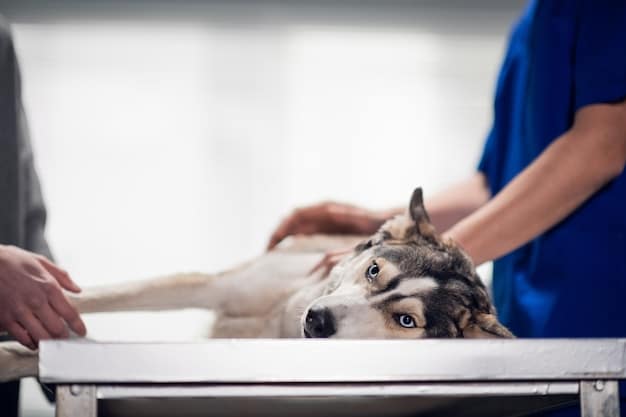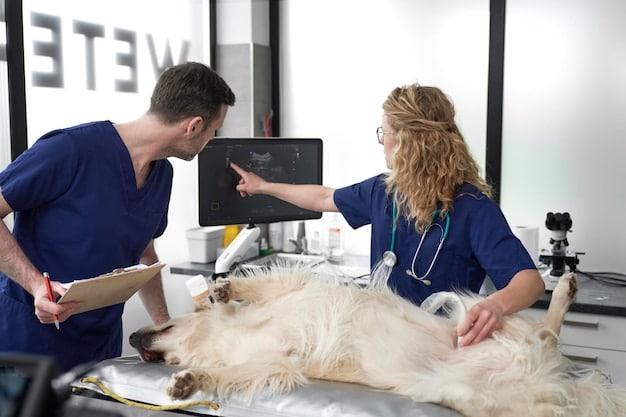Emergency Vet Care Costs: Understanding and Finding Assistance Programs

Anúncios
Emergency vet care costs can be unexpectedly high, but understanding the factors influencing these costs and exploring available financial assistance programs can help pet owners manage and afford critical veterinary services for their beloved animals.
Facing a pet emergency can be overwhelming, especially when unexpected veterinary bills add to the stress. Understanding emergency vet care costs and knowing how to find financial assistance programs can make a significant difference in your pet’s health and your peace of mind.
Anúncios
Understanding the Landscape of Emergency Vet Care Costs
Emergency veterinary care often comes with a higher price tag than routine check-ups. Several factors contribute to these increased costs, including the need for immediate attention, specialized equipment, and after-hours staffing. Being aware of these elements can help you better prepare for potential expenses.
Factors Influencing Emergency Vet Costs
The cost of emergency vet care can vary significantly depending on several factors. Understanding these factors can help you anticipate potential expenses and make informed decisions about your pet’s care.
Anúncios
- Geographic Location: Veterinary costs can vary based on your location, with urban areas typically having higher prices than rural ones.
- Type of Emergency: More complex emergencies, such as surgeries or critical care, will naturally incur higher costs than simpler cases.
- Time of Day: After-hours, weekend, and holiday services usually come with additional charges due to staffing costs.
- Veterinary Clinic: Different clinics have different pricing structures, even within the same geographic area.
Knowing these factors can empower you to ask informed questions and potentially explore different options if possible.
Common Emergency Vet Procedures and Their Associated Costs
Emergency vet care encompasses a wide range of procedures, each with its own set of costs. Understanding the typical expenses associated with common procedures can help you budget and prepare for unforeseen emergencies.

Typical Emergency Procedures and Costs
Common emergency procedures include diagnostic tests, treatments, and surgeries. Here’s a general overview of what you can expect to pay.
- Consultation Fee: $75 – $200 (initial examination and assessment)
- Diagnostic Tests (X-rays, Ultrasounds): $100 – $500 per test
- Blood Work: $80 – $250
- Emergency Surgery: $500 – $5,000+ (depending on complexity and anesthesia)
These costs are estimates and can vary based on the factors mentioned earlier. Always ask for a detailed estimate before agreeing to any procedures.
Navigating the Financial Challenges of Emergency Vet Care
The high cost of emergency vet care can place a significant financial strain on pet owners. However, there are several strategies you can use to navigate these challenges and ensure your pet receives the necessary care without breaking the bank.
Strategies for Managing Emergency Vet Bills
Planning and preparation are key to managing the financial burden of emergency vet care.
- Pet Insurance: Investing in pet insurance can help cover a significant portion of emergency veterinary costs.
- Emergency Savings Fund: Setting aside a dedicated savings fund for pet emergencies can provide a financial cushion when unexpected situations arise.
- Credit Options: Consider credit cards or lines of credit specifically designed for healthcare expenses (like CareCredit).
These strategies can help you mitigate the financial impact of emergency vet care and provide peace of mind.
Exploring Pet Insurance Options for Emergency Coverage
Pet insurance is a valuable tool for managing unexpected veterinary expenses. Understanding the different types of pet insurance plans and what they cover can help you choose the best option for your pet and your budget.
Types of Pet Insurance Plans
Pet insurance plans vary in terms of coverage, premiums, and deductibles. Here’s a breakdown of the most common types:
- Accident-Only Plans: Cover expenses related to accidents and injuries.
- Accident and Illness Plans: Cover both accidents and illnesses.
- Comprehensive Plans: Offer the broadest coverage, including accidents, illnesses, and routine care (such as vaccinations and wellness exams).
When choosing a plan, consider your pet’s breed, age, and health history, as well as your budget.
Financial Assistance Programs for Pet Owners in Need
Several organizations and programs offer financial assistance to pet owners who cannot afford emergency veterinary care. Exploring these resources can provide much-needed support during challenging times.

Organizations Offering Financial Aid
Numerous organizations are dedicated to helping pet owners afford veterinary care. Here are a few notable options:
- The Pet Fund: Provides financial assistance to owners who need veterinary care.
- RedRover: Offers financial aid and support for animals in crisis situations.
- Frankie’s Friends: Provides grants to help families with emergency veterinary care costs.
Research these organizations and their eligibility requirements to determine if they can provide assistance.
Creating a Proactive Plan for Pet Emergencies
Being proactive and prepared can make a significant difference when a pet emergency strikes. Having a plan in place can minimize stress and ensure your pet receives timely and appropriate care.
Steps to Create an Emergency Plan
A comprehensive emergency plan should include:
- Identifying Local Emergency Vets: Knowing the location and contact information of nearby emergency vet clinics.
- Having a Pet First-Aid Kit: Assembling a kit with essential supplies for basic first aid.
- Documenting Medical History: Keeping your pet’s medical records readily available.
Having these elements in place can help you respond quickly and effectively in an emergency.
| Key Point | Brief Description |
|---|---|
| 💰 Emergency Costs | Higher due to immediate care, specialized equipment, and after-hours staffing. |
| 🏥 Common Procedures | Consultation, diagnostic tests, blood work, and emergency surgery are typical. |
| 🛡️ Pet Insurance | Can cover a significant portion of emergency costs; consider accident-only, accident and illness, or comprehensive plans. |
| 🐾 Financial Aid | Organizations like The Pet Fund, RedRover, and Frankie’s Friends offer assistance. |
Frequently Asked Questions
▼
Emergency vet care costs more due to factors like the need for immediate attention, specialized equipment and staffing, and after-hours services.
▼
Pet insurance can cover a significant portion of emergency vet bills, reducing the financial burden on pet owners during unforeseen crises.
▼
Organizations like The Pet Fund, RedRover, and Frankie’s Friends offer financial aid for emergency veterinary care to eligible pet owners.
▼
Your plan should include the location of emergency vets, a pet first-aid kit, and readily available medical records to facilitate quick action.
▼
Yes, you can prepare by investing in pet insurance, starting an emergency savings fund, and familiarizing yourself with local emergency vet options.
Conclusion
Understanding the costs associated with emergency vet care and exploring available financial assistance programs can empower you to provide the best possible care for your pet during unexpected crises. By being proactive and prepared, you can navigate these challenges with greater confidence and peace of mind.






